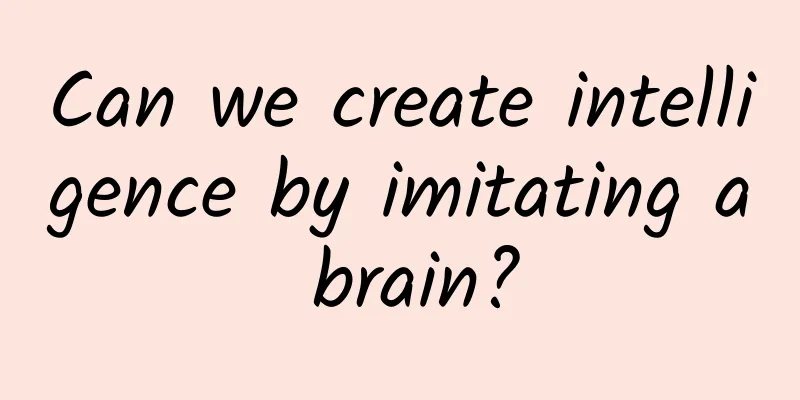Can we create intelligence by imitating a brain?

|
The brain is not a computing device, nor is it a simple information processing system, but a meaning extraction system. Can it really be reverse engineered? Written by Gu Fanji (School of Life Sciences, Fudan University) No one will deny that the human brain is the most complex "machine" in the world. It can achieve many functions that modern and advanced machines cannot do. In mathematical jargon, the brain provides evidence for the "existence" of these advanced functions. So a natural idea is to learn from the human brain, seek inspiration and inspiration from it, and create more intelligent machines. However, under the guidance of this idea, two different ideas have emerged. One approach is to first understand how the human brain works, and then use engineering technology to replicate this mechanism. If we want to be more specific, perhaps we can use a passage from American inventor Jeff Hawkins' recent book, A Thousand Brains, to express it: "To create truly intelligent machines, we first need to reverse engineer the brain." "The fastest way to achieve machine intelligence is to understand how the brain works and then imitate these principles in computers." [1] In a nutshell, the core of this idea is to use the human brain as a model and use engineering technology to replicate the brain through reverse engineering. Reverse engineering is an engineering method or means by which people try to use deductive reasoning to understand how existing equipment, processes, systems or software, about which they know nothing about the principles, accomplish a task. It is essentially to disassemble the system and analyze it to understand its working mechanism so that it can be copied or enhanced. In layman's terms, it is also called "copying". Although the specific methods of reverse engineering vary depending on the object to be copied, the process usually includes three basic steps: information extraction, modeling and verification. [2] Another idea is to seek some "inspiration" from brain research, and then use engineering and technical means to develop new machines without worrying about whether the structure, function, principle or mechanism is "similar" to the brain. As long as the result can solve engineering and technical problems and is economical and feasible, it is fine without having to stick to the details of the working principle. There is a huge difference between the two ideas above. In fact, many scientists have pointed this out long ago and used birds and airplanes as analogies. People are undoubtedly inspired by the ability of birds to fly when they build airplanes, but modern airplanes have nothing in common with the flying behavior of birds in terms of structure, function, principle, or mechanism. The "ornithopter" drawn by Leonardo da Vinci during the Renaissance was more like a bird. It relied on flapping wings to fly, which could be said to be a reverse engineering of bird flight. Unfortunately, it has always remained at the sketch stage (Figure 1) and has never been applied. However, if someone really tried to realize Leonardo da Vinci's sketch with modern technology, it would probably be difficult to get any good results. Figure 1: The flapping-wing aircraft designed by Leonardo da Vinci Nicolelis and Mauk's call to each other The first approach—reverse engineering the human brain to create intelligent machines—seems like a shortcut that not only appeals to engineers but also fascinates some neuroscientists. In the 2018 book Think Tanks: 40 Neuroscientists Explore the Biological Roots of Human Experience[3] edited by David J. Linden, there is an article that represents this approach. "In principle, there is no reason why we cannot eventually build machines that think" The title of Michael D. Mauk's article captures his central idea: "There is no principle that prevents us from eventually building machines that think" [4] . In it, he acknowledges that the brain is of staggering size and that some details are still unclear, but argues that there is no insurmountable chasm to building an artificial mind; all that is needed is "hard work" and faster computers with more memory. Mauk believes that, "Like any computing device, to understand the brain, we need to identify the characteristics of the main components (neurons), the properties of the connections between the components (synapses), and the patterns of interconnections (wiring diagrams). The number is indeed astonishing, but the key is that the rules obeyed by neurons and their connections are limited and understandable." He emphasized that now we know that there are only a few hundred types of neurons, so we can study the input-output rules of each type. The properties of different synapses and their plasticity rules are also limited and understandable. Although the number of synaptic connections is large, these connections are not random, and they also obey some rules that we can recognize. Now the large-scale "connectome" project will provide a neural wiring diagram of the whole brain. Therefore, to build an artificial brain, you only need to understand these limited rules. Mauke argues the above view from two aspects: First, building an artificial brain and copying a specific person's brain are two different things. Only when copying a specific person's brain do you need to know all the specific connections in his brain. These connections are not only determined by nature, but also by acquired experience, and each connection is specific and needs to be figured out. However, to build a general artificial brain, you only need to obey the basic rules of connection. Second, we can do a thought experiment: suppose we can create an artificial neuron with the same input-output function as a real neuron, and use it to replace the corresponding biological neuron in the organism, then the subject (organism) will not feel any different. In this way, the corresponding biological neurons are replaced one by one with equivalent artificial neurons, and the subject still does not feel any difference. After all the replacements, the final artificial neuron network is an artificial brain. Mao Ke's thought is very representative among some people. In his article, he mentioned another article in the collection that was contrary to his view, but he did not refute it. That article held the second idea: “It is impossible to simulate the human brain with any Turing machine” The penultimate article in Think Tank is titled “The human brain, the true creator of everything, cannot be simulated by any Turing machine” [5] , written by Miguel AL Nicolelis, a leading figure in brain-computer interface. The title also accurately indicates Nicolelis’ central idea. Although he did not directly refute Mauk’s argument, his content largely pointed out the fundamental problems in Mauk’s argument. Nicolelis's main arguments are: Some people in society and even in academia believe that the human brain is just an information processing machine, or a physical version of a digital computer. Based on this misleading statement, people believe that one day a supercomputer can be used to simulate or even copy the human brain, and that all conscious and unconscious experiences of a person's life can be stored in a digital medium, thus achieving digital immortality; on the other hand, complex content can also be uploaded to the brain, so that people can use or possess a new language or new technology or new knowledge in an instant. This idea is rooted in a misunderstanding of information and computation. Although Claude Shannon reminded us when he proposed his pioneering information theory, his definition of information only addresses the quantification problem of transmitting messages in noisy communication channels, that is, it only involves "reducing the uncertainty about the sender's state", but does not involve the content and meaning of information at all. For the brain, the content and meaning of information are the most important aspects. The error in the term “brain computing” is even more serious. Sometimes people generalize “computation” to be synonymous with information processing, and sometimes they limit “computation” to operations performed in von Neumann computers, and they keep switching between the two. Alan Turing, a pioneer of modern digital computers, pointed out that if a task can be reduced to a mathematical algorithm that can be completed in a finite number of steps, then it can be simulated using the universal Turing machine he proposed and is said to be “computable.” According to the Church-Turing assumption, any device that can perform such a computation (such as a digital computer) is equivalent to a universal Turing machine, and such a computation can be called a computation in the Turing sense. It was Turing who first pointed out that there are problems that are uncomputable in this sense. [6] Unfortunately, the brain and many of its advanced functions are not computable in the Turing sense. Therefore, no matter how advanced a supercomputer becomes, it is impossible to replicate the human brain. The brain operates with both digital and analog components, and there is a recursive, nonlinear dynamic interaction between the two, which far exceeds the capabilities of a Turing machine. The human brain is not just a device that passively decodes external information. In fact, the brain predicts what might happen in the future according to its internal model. The brain is always one step ahead to predict what will happen. If the prediction is wrong, it will learn from the error and update the internal model. This is "neural plasticity". Although Nicolelis did not criticize Mauk by name, he did have some very strong words to say: “If this absurd claim were confined to Hollywood science fiction films, it would not matter much. But when certain computer scientists and even neuroscientists repeat this myth in public and charge European and American taxpayers billions of dollars in their pointless pursuit of simulating the human brain on a digital medium, the problem becomes far more serious.” [5] Out of courtesy as an inviter, Linden played Tai Chi between these two diametrically opposed views. In the postscript of the book, he wrote: "Who is right about this important issue? We don't know. ... This is often the case with the development of science." However, there is no need for us to play Tai Chi. In my opinion, both of Mauk's arguments are untenable. His first argument only shows that it is more difficult to copy a specific person's brain than to build a general human brain, which cannot be used as a reason for the latter task (building a general brain) to be easy to achieve. Mauk's second argument is a substitution of conditions. In his thought experiment, the hypothetical neural network is still in the subject's body, surrounded by glial cells, cerebrospinal fluid, blood vessels and other tissues (the number of glial cells is 10 times that of neurons, and we still don't know their functions), and maintains all normal connections with the body. In other words, this "artificial neural network" is still "embodied" and has not been separated from the internal environment of the subject's body. Since the subject can move freely, it is also not separated from the external environment and social environment. This is completely different from an isolated group of neurons separated from the body. Just think of the example of the wolf boy: although the wolf boy's brain is structurally exactly like a normal human brain, and is even embodied and interacts with the external environment, the subject loses its normal mind simply by being separated from the social environment. Therefore, an isolated set of artificial neurons, no matter how its internal connections are, is unlikely to have what Mauk calls an "artificial mind." Mauk took a completely reductionist approach. He believed that as long as the properties of the components of a machine and the properties of their interconnections are understood, the properties of the entire system can be understood. This may be true for a simple system with only two levels, where the activities of the upper level have no effect on the lower level, but for an extremely complex system like the brain with many levels, it is probably impossible to understand. Of course, some people will argue that for a multi-level system, we can start from the top layer and work our way down layer by layer, reducing each adjacent level, and finally we can use the bottom layer of biological macromolecules and their interactions to explain the mind. This is a "linear causal chain" idea, assuming that the activities of the next level are the cause and the activities of the previous level are the effect. But for a system like the brain, not only does the activity of the next level contribute to the activity of the upper level, but the activity of the upper level also affects the activity of the next level, and they are mutually causal. Moreover, this relationship is not limited to adjacent levels, but can also span many levels, so this is a "circular causal relationship." For such a system, a thorough reductionist strategy will not work. At present, at a very low level, it is still possible to obtain certain results using reductionist strategies, such as simulating biological neurons or manufacturing chips, but once you rise to the top level such as mind or even consciousness, this will not work. From a logical point of view, the title of Mauk's article, "In principle, there is no reason why we cannot eventually build a thinking machine," is not wrong, because the brain itself is also a physical system, so the possibility of building an artificial physical system with thinking cannot be completely ruled out. However, logical possibility and actual feasibility are two different things. This is why when reviewing science and technology fund applications, not only the innovation of the application should be considered, but also the feasibility of its technical route. It is meaningless for Mauk to talk about possibility without considering feasibility. The carrot dangling before the donkey: Markram’s promise Nicolelis is worried about certain computer scientists or even neuroscientists who are asking European and American taxpayers for billions of dollars to simulate the human brain. They are probably scientists represented by Henry Markram, who successfully applied for the 1 billion euro "Human Brain Project" (HBP) in the European Union in 2013. In his application, Markram proposed to build an artificial human brain on a supercomputer within ten years. His core idea is reflected in an article he wrote in 2012 to promote his application, "The Human Brain Project": "The key to our research method is to carefully study the basic blueprint on which the brain is based: that is, the set of principles that have constructed the brain throughout evolution and again during embryonic development. In theory, these principles are all the information we need to build a brain. People's doubts are not unreasonable: the complexity generated by these principles is amazing - that's why we need supercomputers to solve this problem. But discovering these principles is much easier. If we find these principles, then logically, there is no reason why we cannot use the blueprint of the biological brain to build a 'silicon brain' in the same way." [7] So what is Markram’s performance? In 2009, in an interview with Discover magazine, he promised to simulate a rat brain within three years (that is, by 2012)[8] . However, in 2012, he made the same promise in the Human Brain Project (that is, delayed to 2015). However, until 2015, he was forced to step down due to a series of problems such as unrealistic goals, and he has not been able to fulfill his promise. The “small goal” of simulating the rat brain is like the carrot hanging in front of the donkey’s head. Although it is only three steps away, it is always out of reach, let alone cloning the human brain through reverse engineering. As for the ins and outs of this plan, I have already made a long article in Fanpu to analyze it [9] , so I will not repeat it here. Strangely, after another three years, when the “revolutionary” Human Brain Project has given up this fantasy, Mauk still wants to pick up the old idea [4] . Three years later, Hawkins reiterated his view with a slight change [1], and it still received support from many people. This is worthy of deep thought and further analysis. Figure 2 The promise of reverse engineering a mouse brain. The evolutionary approach is different from the engineer's approach In the book series Brain and Artificial Intelligence co-authored with Karl Schlagenhofer, I pointed out: "Nature does not act like engineers. Engineers prefer uniformity, while nature prefers variability and diversity. Before engineers build a system, they have a blueprint in mind. They hope that there are as few types of components as possible, and each component in the same type is exactly the same, so that they can analyze, design, build and repair more easily. However, nature does not deliberately design organisms. It allows individuals that are more or less different to compete with each other. No two individuals are exactly the same. In the competition, only individuals that are better adapted to their environment have a better chance of surviving and producing the next generation. Edelman's neural Darwinism also assumes that there is competition between the circuits or modules of the nervous system, and only those circuits or modules that are suitable for achieving their goals can be preserved." [10] It is of course wishful thinking for Markram and others to pin their hopes on this non-existent natural "blueprint". Molecular biologist Francois Jacob also said: "Evolution is a tinkerer, not an engineer." When faced with new tasks, nature does not make a completely new design from the top according to logic, but simply adds new things on the existing foundation. This determines that the brain is not as perfect as most people think. As Linden said in his book The Accidental Mind: "No matter from which level, from brain regions, circuits to cells and molecules, the brain is a poorly designed and inefficient mass, but it works surprisingly well. The brain is not the ultimate and universal supercomputer, it is not a genius improvisation on a blank sheet of paper. The brain is a unique building, accumulated millions of years of evolutionary history." [11] Furthermore, the brain is not a computational device, or even just an information processing device, but a meaning extraction system.[12] Little is known about how to study such a system. Finally, the human brain is the product of more than 500 million years of evolution. We may be able to gradually understand the secrets of brain function, but few people dare to assert when we will be able to clearly understand brain function. Therefore, when engineering technology urgently needs to solve certain problems similar to human brain function, we cannot wait to figure out the corresponding brain mechanism before formulating a plan. Instead, we can only seek inspiration from known knowledge about the brain, or simply ignore the brain mechanism and seek solutions from engineering technology. In fact, even if we know the brain mechanism, it may not be applicable to engineering. Although the "Darwin machine" designed by Edelman based on the cerebellum's motor control mechanism can also drive freely on a curve [13], it was pure engineering artificial intelligence technology, not the Darwin machine, that really put driverless cars on the road. Of course, the Darwin machine may have potential significance for deepening our understanding of the cerebellum's motor control mechanism. Figure 4. Darwin machine freely driving in a curve. [13] Therefore, whenever possible, engineers should seek inspiration from brain research and use appropriate engineering techniques to achieve certain brain-like functions, rather than blindly copying the structure and mechanism of biological brains. Deep learning, which is now very popular in artificial intelligence, may be inspired by the multi-level processing of the visual system and can be used as a typical example of "brain inspiration": The visual system first extracts the contrast in space in the retina, that is, the border; then the simple cells in the primary visual cortex extract the line segments with specific orientations in specific parts, while the complex cells extract the line segments with specific orientations in any part of the receptive field, and so on... extracting more and more global features, and finally integrating the relevant features in the brain to recognize the object. This last neurobiological mechanism, called the "binding problem", still has some assumptions, such as synchronous oscillation, which has not yet been finally solved. IT engineers borrowed from the multi-level processing mechanism of the visual system and set up many intermediate layers of networks for "deep learning". Although their algorithms are very different from the mechanisms of biological visual systems, they have achieved remarkable results. Of course, if the mechanism in the brain happens to be suitable for engineering technology implementation, then naturally we can also learn from the brain's solution. Judging from the current research situation, people have studied the lower-level brain tissues, such as the structure and function of neurons, more clearly, so the details they have learned are more numerous and in-depth. A relatively successful example in this regard is the "neuromorphic chip" [Note 1] . Biological neurons cannot compare with electronic devices in terms of speed and reliability, but their pulse output form makes their power consumption much lower than that of current electronic devices. Neuromorphic chips simulate this and can reduce power consumption by 4 orders of magnitude. Therefore, they are expected to be used in occasions with high energy consumption requirements, such as aerospace engineering. However, if a new technology wants to achieve great development, widespread application is the biggest promoter. The recent chatbot ChatGPT has become popular all over the world, and its servers have been overwhelmed. The energy consumption cost has become so high that it is unbearable. Whether neuromorphic engineering [14] can take this opportunity to realize its ambitions is worth looking forward to. [Note 1]: The popular translation now is "neuromorphic chip". If we break this word into the prefix neuro and the root morphic, they are indeed "neural" and "morphic" respectively, but this chip has nothing to do with the "morphology" of nerve cells or nervous systems. It's just that the unit in this chip - the neuron - is closer to the biological neuron in terms of mechanism, or "neuromorphic". The author thinks that the translation of "neuromorphic chip" is easy to mislead readers. The author thinks that no one would translate butterfly into cream fly. Figure 5 A neuromorphic chip. [15] The higher the level of brain function, the less humans know about the mechanism behind it, and the less they can learn from it. They can only use engineering technology to achieve this function. This is generally the route that current artificial intelligence takes. Specifically, we do not seek to create an AI similar to the human brain, but strive to make AI make decisions like the human brain, regardless of whether its decision-making mechanism is different from that of the human brain. In general, engineering technology should seek inspiration from brain research rather than copy or replicate it. Using the term accurately: brain-like or brain-inspired? In China, we often hear the term "brain-like". Readers tend to understand "brain-like" as "similar to a real brain", or more accurately, reverse engineering the brain. But the speaker may not mean this. Some people mean to seek inspiration from brain research and then use engineering technology to achieve certain functions similar to the brain. The misuse of the term "brain-like" may have historical reasons: at the end of the last century and the beginning of this century, there was indeed a wave of "brain-like" thinking in the world, thinking that engineering and technical problems could be solved by reverse engineering the brain. Of course, there are still a few scientists who hold this view, such as the ones we introduced earlier. However, most scientists rarely use the term brain-like anymore, and have changed to brain-inspired. That is, they no longer reverse engineer the brain to copy it, but only seek inspiration from brain research when possible, and use engineering technology to achieve certain functions similar to the brain. However, many people in China still use the term "brain-like", perhaps because they think it sounds simple and attractive. The author believes that although this term is "conventional", it is ambiguous and will mislead readers. Should we decisively abandon this "convention" and "rectify the name"? The author has noticed that some scientists are already doing this. Should we be more conscious of distinguishing these two technical routes? References [1] Hawkins J (2021) A Thousand Brains: A New Theory of Intelligence. Basic Books. Chinese translation: Hawkins, translated by Liao Lu et al. (2022) Thousand Brain Intelligence, Zhejiang Education Publishing House. [2] https://en.wikipedia.org/w/index.php?title=Reverse_engineering&oldid=1128484181 [3] Linden DJ (ed.) (2018) Think Tank: Forty Neuroscientists Explore the Biological Roots of Human Experience. Yale University Press. New Haven and London. [4] Mauk MD (2018) There is no principle that prevents us from eventually building machines that think. In Linden DJ (ed.) (2018) Think Tank: Forty Neuroscientists Explore the Biological Roots of Human Experience. Yale University Press. New Haven and London. [5] Nicolelis MAL (2018) The human brain, the true creator of everything, cannot be simulated by any Turing machine. In Linden DJ (ed.) (2018) Think Tank: Forty Neuroscientists Explore the Biological Roots of Human Experience. Yale University Press. New Haven and London. [6] https://en.wikipedia.org/w/index.php?title=Hypercomputation&oldid=1133373703 [7] Markram H (2012) The human brain project. Sci. Am. 306(6):50-5512. [8] Kushner, D (2009), The Discover interview Henry Markram. Discover 2009(12):61-77 [9] Gu Fanji (2019) EU Human Brain Project: Can money and big plans lead to breakthroughs in basic science? Fanpu, August 20, 2019 [10] Gu Fanji and Karl Schlagenhofer, The New World of Brain Research, translated by Gu Fanji (2019), Shanghai Education Press [11] Linden DJ (2007) The Accidental Mind: How Brain Evolution Has Given Us Love, Memory, Dreams, and God. Harvard University Press. Chinese translation: Lin Deng, translated by Shen Ying et al. (2022) Imperfect Brain: How Evolution Gives Us Love, Memory, and Dreams, Shanghai Science and Technology Press [12] Freeman WJ (1999) How Brains Make Up Their Minds. Weidenfeld & Nicolson [13] McKinstry, JL, Edelman, GM, and Krichmar, JL (2006). A cerebellar model for predictive motor control tested in a brain-based device. Proc Natl Acad Sci USA 103, 3387-3392. [14] Gu Fanji (2019) Artificial brain and neuromorphic structure engineering. Nature 41(1): 35-43 [15] Abbott, J. et al. (2020) A nanoelectrode array for obtaining intracellular recordings from thousands of connected neurons. Nat. Biomed. Eng. 4, 232–241 This article is supported by the Science Popularization China Starry Sky Project Produced by: China Association for Science and Technology Department of Science Popularization Producer: China Science and Technology Press Co., Ltd., Beijing Zhongke Xinghe Culture Media Co., Ltd. Special Tips 1. Go to the "Featured Column" at the bottom of the menu of the "Fanpu" WeChat public account to read a series of popular science articles on different topics. 2. Fanpu provides a function to search articles by month. Follow the official account and reply with the four-digit year + month, such as "1903", to get the article index for March 2019, and so on. Copyright statement: Personal forwarding is welcome. Any form of media or organization is not allowed to reprint or excerpt without authorization. For reprint authorization, please contact the backstage of the "Fanpu" WeChat public account. |
<<: With the help of "direct imaging", exoplanets can be "believed"
>>: Achieved for the first time! Congratulations to Chinese scientists
Recommend
A usable brand planning template
If you have never written a brand planning propos...
Civil Code Practice Essentials Course - Property Rights and Contracts Special Lectures Value 599 Yuan - Baidu Cloud Download
This set of courses comes from Zhiqia - Civil Cod...
Liu Jiangfeng jokes that he is in danger. Can the new S1 change the world's view of Coolpad?
Just three years ago, "China Cool Union"...
Video tutorial for beginners on how to play King of Glory! Video tutorial on how to play King of Glory! Baidu Cloud Disk resources free download
As Honor of Kings becomes more and more popular, ...
Fruit-flavored e-cigarettes are quietly popular among middle school students! Severe cases can cause "popcorn lung"
Recently, a type of fruit-flavored e-cigarette ha...
Douban, the mobile Internet can no longer wait for your confusion
A few days ago, when I was chatting with some ent...
The "Tianshan Child-like Grandma" of the Animal World: I don't want to grow up...
Produced by: Science Popularization China Author:...
New products not selling well? These 11 ways to double your product sales
"This new product is great, you have to sell...
Although Microsoft has released a VR headset, its ultimate ambition is mixed reality
Although Surface Studio was the protagonist of Mi...
Facebook enters live video streaming. Will live streaming become a new trend?
Apple held its autumn new product launch conferen...
If you have enough budget to buy a car, would you choose Volvo XC40 or Lynk & Co 01?
When it comes to the MQB platform, everyone will ...
Apple releases first developer preview of iOS 11.4 beta
Not long ago, Apple officially pushed out iOS 11....
Ultra-portable display Slidenjoy trial notebook external perfect match
For laptop users, multi-screen configuration is b...
The driving core of brand planning and promotion!
In the era of mobile Internet, visualization of b...
The mobile phone industry presses the "recovery button", 5G becomes a hope for breakthrough
With the effective control of the COVID-19 epidem...









